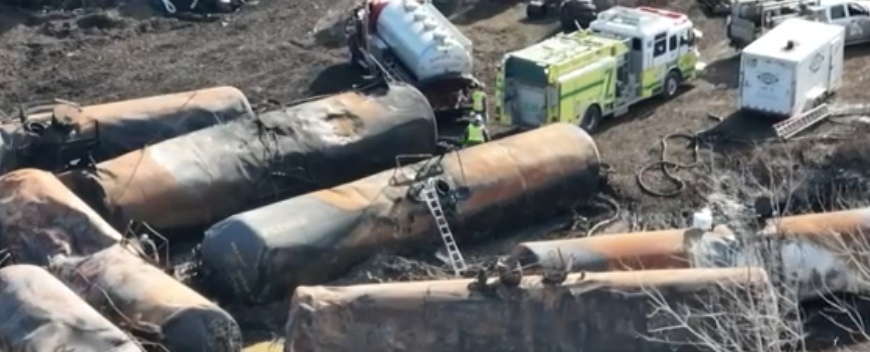After Ohio toxic train wreck, Norfolk Southern backs out of meeting
Feb 16, 2023, 7:30 AM | Updated: 8:01 am

Though an evacuation order was lifted last week, some residents refuse to return amid fears the water, air, soil and surfaces in the village of 5,000 are still not safe.
The odor has lingered nearly two weeks after a Norfolk Southern train carrying hazardous materials derailed near the Ohio-Pennsylvania line, igniting an inferno that burned for days and prompted evacuations in surrounding areas while crews managed detonations to release vinyl chloride, which can kill quickly at high levels and increase cancer risk.
Though an evacuation order was lifted last week, some residents refuse to return amid fears the water, air, soil and surfaces in the village of 5,000 are still not safe.
And on Wednesday, Norfolk Southern officials announced they would no longer take part in a community meeting scheduled that evening about the situation, citing threats to employees.
“We have become increasingly concerned about the growing physical threat to our employees and members of the community around this event stemming from the increasing likelihood of the participation of outside parties,” the company said in a release.
Company officials had hoped to join local leaders Wednesday evening to update the community on the steps they are taking to “safely clean up the accident site and to provide the latest results from ongoing water and air testing,” the release reads.
A community meeting still was expected to go forward Wednesday evening, and plaintiff’s attorneys invited residents to meet with them beforehand to discuss the derailment’s impact.
Since the derailment, many residents in East Palestine remain plagued with anxiety. Some, like Velez, are spending small fortunes to try to keep their families safely away from the place they used to call home.
“My wife is a nurse and is not taking any chances exposing us and our two young children to whatever is now in our town,” Velez wrote on Facebook. “The risk and anxiety of trying to live in our own home again is not worth it.”
On Wednesday, state officials again determined water coming from the municipal system was safe to drink, after test results from five wells that supply the system – covered by steel casing – showed no contaminants, the Ohio governor’s office said.
Still, the Ohio Environmental Protection Agency encourages residents who get water from private wells to get those wells tested, because those wells may be closer to the surface than the municipal wells, the governor’s office said.
The evacuation order was lifted February 8, five days after the derailment, after earlier air and water sample results led officials to deem the area safe.
Nevertheless, worrying signs continue to emerge, including a newly public document that says potentially contaminated soil has not yet been removed from the site – a critical step experts say should be completed quickly so that toxic materials are not further dispersed into the environment and groundwater.
Long-term effects stoke residents’ anxiety
The 100-car freight train that derailed February 3 was carrying hazardous materials including vinyl chloride, ethylene glycol monobutyl ether, ethylhexyl acrylate, isobutylene and butyl acrylate, the US Environmental Protection Agency said. Of those, the vinyl chloride gas that caught fire could break down into compounds including hydrogen chloride and phosgene, a chemical weapon used during World War I as a choking agent, according to the EPA and US Centers for Disease Control and Prevention.
Vinyl chloride – a volatile organic compound, or VOC, and the most toxic chemical involved in the derailment – is known to cause cancer, attacking the liver, and can also affect the brain, Maria Doa of the Environmental Defense Fund told CNN.
Cleanup and monitoring of the site could take years, Kurt Kohler of the Ohio EPA’s Office of Emergency Response said February 8, vowing that after the emergency response, “Ohio EPA is going to remain involved through our other divisions that oversee the long-term cleanup of these kinds of spill.” The federal EPA, too, will “continue to do everything in our power to help protect the community,” Administrator Michael Regan said Tuesday.
But it’s Norfolk Southern who is responsible for cleaning up the site, according to a February 10 notice sent by the federal EPA.
In a document sent to the EPA and recently made public by the agency, a company contracted by Norfolk Southern for cleanup efforts did not list soil removal among completed activities.
Removal of soil that has come into contact with hazardous chemicals is a key cleanup action at spill sites, experts say.
“Contaminated soil will continue (to) leech contaminants, both up into the air, and down into the surrounding ground,” Richard Peltier, an environmental health scientist at the University of Massachusetts at Amherst, told CNN in an email. “Every time it rains, a flood of new contaminants will enter the ecosystem.”
The railroad reopened the rail line on February 8 after taking steps including a controlled release of a toxic chemical from certain cars.
It is not yet known what significance or impact the soil that was not removed prior to the rail line reopening may have on surrounding areas.
CNN asked Norfolk Southern why it had not removed contaminated soil before reopening the site, and if it had filled in areas of contaminated soil and chemicals in order to reopen the rail line.
A spokesperson for the company said “some soil is moved around” during the initial response phase. The company is continuing to “remediate the site” including by removing soil, spokesperson Connor Spielmaker added.
The federal EPA and Ohio EPA have not responded to repeated questions from CNN about removal of contaminated soil.
Long-term effects stoke residents’ anxiety
East Palestine resident Ben Ratner and his family worry about the longer-term risks that environmental officials are only beginning to assess, he told CNN this week.
The Ratner home, for instance, was tested and cleared for VOCs, he said. And so far, no chemical detections were identified in the air of 291 homes screened by the EPA for hazardous chemicals including vinyl chloride and hydrogen chloride, it said in a Monday news update, with schools and a library also screened and 181 more homes to go.
But the Ratners – who played extras in a Netflix disaster film with eerie similarities to the derailment crisis – still are feeling “an ever-changing mix of emotions and feelings just right from the outset, just the amount of unknown that was there,” said Ben, who owns a cafe a few towns over and isn’t sure he still wants to open another in East Palestine.
“It’s hard to make an investment in something like that or even feel good about paying our mortgage whenever there might not be any value to those things in the future,” he said. “That’s something tough to come to grips with.”
Norfolk Southern said Wednesday it was creating a $1 million charitable fund to support East Palestine, saying it was “committed” to the community “today and in the future.”
“We will be judged by our actions. We are cleaning up the site in an environmentally responsible way, reimbursing residents affected by the derailment, and working with members of the community to identify what is needed to help East Palestine recover and thrive,” Norfolk Southern President and CEO Alan Shaw said in a release.
‘Why does it hurt me to breathe?’
The EPA, with the Ohio National Guard and a Norfolk Southern contractor, also has collected air samples – checking for vinyl chloride, hydrogen chloride, carbon monoxide, phosgene and other compounds – in the East Palestine community, it had said. Air monitoring results posted Tuesday at the EPA’s website include more than a dozen instruments, each with four types of measures – and each stating its “screening level” had not been exceeded.
But when Velez returned Monday for a short visit to the neighborhood where his family has lived since 2014 to check his home and his business, he developed a nagging headache that, he said, stayed with him through the night – and left him with a nagging fear.
“If it’s safe and habitable, then why does it hurt?” he told CNN. “Why does it hurt me to breathe?”
Despite Velez’s experience, air quality does not appear to be the source of headaches and sore throats among people or deaths of animals such as cats and chickens in and around the derailment zone, Ohio Health Director Dr. Bruce Vanderhoff said Tuesday.
“In terms of some of the symptoms of headache, et cetera, unfortunately volatile organic compounds share, with a host of other things, the ability to cause very common symptoms at the lower levels – so headache, eye irritation, nose irritation, et cetera,” he said. “I think that we have to look at the measured facts – and the measured facts include the fact that the air sampling in that area really is not pointing toward an air source for this.”
“Anecdotes are challenging because they’re anecdotes,” Vanderhoff said. “Everything that we’ve gathered thus far is really pointing toward very low measurements, if at all.”
As to odor, residents “in the area and tens of miles away may smell odors coming from the site,” Ohio EPA spokesperson James Lee told CNN on Wednesday. “This is because some of the substances involved have a low odor threshold. This means people may smell these contaminants at levels much lower than what is considered hazardous.”
“If you experience symptoms, Columbiana County Health Department recommends calling your medical provider,” the EPA said.
Wreck and spill blamed for thousands of dead fish
The Ratner family is limiting its water use because of unknown affects, Ben Ratner said. Velez worries “every time we turn the water on or give my daughter a bath could potentially be hazardous,” he wrote on Facebook.
Some waterways indeed have been contaminated – but the Ohio Environmental Protection Agency is confident contaminants are contained, said Tiffany Kavalec, the agency’s division chief of surface water.
No vinyl chloride has been detected in any down-gradient waterways near the train derailment, she said Tuesday. But an estimated 3,500 fish across 12 species are estimated to have been killed by the derailment and spillage, said Mary Mertz, director of Ohio’s Department of Natural Resources.
“Fire combustion chemicals” flowed to the Ohio River, “but the Ohio River is very large, and it’s a water body that’s able to dilute the pollutants pretty quickly,” Kavalec said. The chemicals are a “contaminant plume” the Ohio EPA and other agencies have tracked in real time and is believed to be moving about a mile an hour, she said.
The “tracking allows for potential closing of drinking water intakes to allow the majority of the chemicals to pass. This strategy, along with drinking water treatment … are both effective at addressing these contaminants and helps ensure the safety of the drinking water supplies,” Kavalec said, adding they’re pretty confident “low levels” of contaminants that remain are not getting to customers.
Even so, authorities strongly recommend people in the area drink bottled water, especially if their water is from a private source, such as a well.
Velez also worries about unknown long-term effects of the burned train contents, he said.
He and his family have been Airbnb-hopping 30 minutes from their home since they evacuated, but rental options and their finances are running out, he said, and a friend set up a GoFundMe to help the family.
“Unfortunately, many of us residents are stuck in the same situation and the sad truth is that there is no answer,” he wrote. “There is no viable solution other than to leave and pay a mortgage on a potentially worthless home.”













